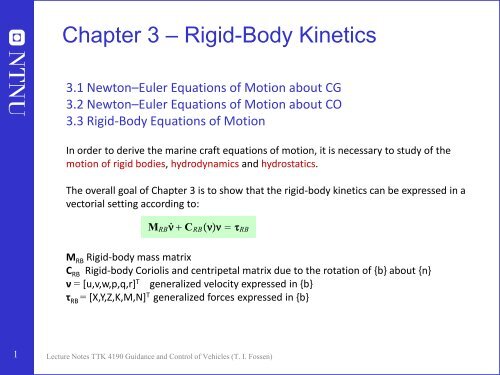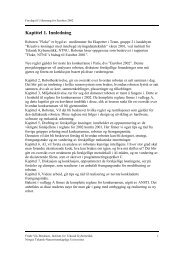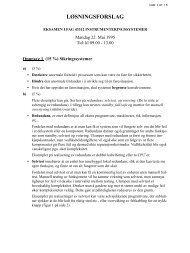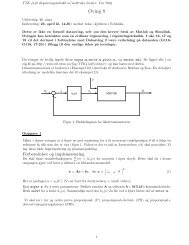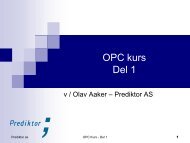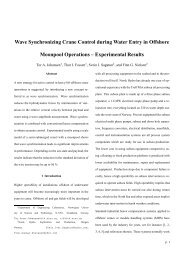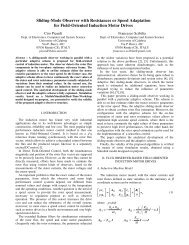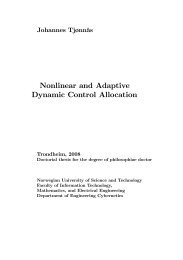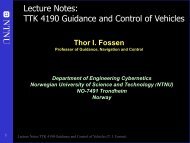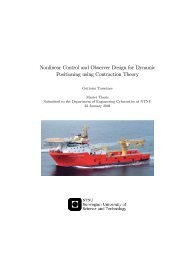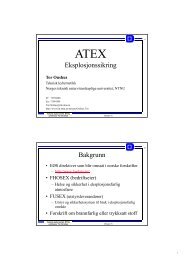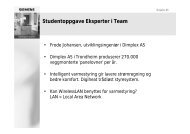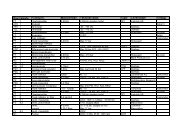Create successful ePaper yourself
Turn your PDF publications into a flip-book with our unique Google optimized e-Paper software.
Chapter 3 – Rigid-Body Kinetics<br />
3.1 Newton–Euler Equations of Motion about CG<br />
3.2 Newton–Euler Equations of Motion about CO<br />
3.3 Rigid-Body Equations of Motion<br />
In order to derive the marine craft equations of motion, it is necessary to study of the<br />
motion of rigid bodies, hydrodynamics and hydrostatics.<br />
The overall goal of Chapter 3 is to show that the rigid-body kinetics can be expressed in a<br />
vectorial setting according to:<br />
M RB C RB RB #<br />
M RB Rigid-body mass matrix<br />
C RB Rigid-body Coriolis and centripetal matrix due to the rotation of {b} about {n}<br />
ν = [u,v,w,p,q,r] T generalized velocity expressed in {b}<br />
τ RB = [X,Y,Z,K,M,N] T generalized forces expressed in {b}<br />
1<br />
Lecture Notes TTK 4190 Guidance and Control of Vehicles (T. I. Fossen)
Chapter 3 – Rigid-Body Kinetics<br />
The equations of motion will be represented in two body-fixed reference points:<br />
1) Center of gravity (CG), subscript g<br />
2) Origin o b of {b}, subscript b<br />
These points coincides if the vector<br />
r g 0 CO CG<br />
Time differentiation of a vector<br />
in a moving reference frame {b} satisfies<br />
i d<br />
dt a b d<br />
dt a b/i a<br />
Time differentiation in {b} is denoted as<br />
a : b d<br />
dt a <br />
{b}<br />
r b/i<br />
r g/i<br />
r g<br />
2<br />
{i}={n}<br />
inertial frame
3.1 Newton-Euler Equations of Motion<br />
about CG<br />
Coordinate-free vector: A vector v b/n , velocity of {b} with respect to {n}, is defined by its<br />
magnitude and direction but without reference to a coordinate frame.<br />
i<br />
Coordinate vector: A vector v b/n<br />
decomposed in the inertial reference frame is denoted by v b/n<br />
Newton-Euler Formulation<br />
Newton's Second Law relates mass m, acceleration v g/i and force f g according to:<br />
mv g/i fg<br />
Isaac Newton (1642-1726)<br />
where the subscript g denotes the center of gravity (CG).<br />
Euler's First and Second Axioms<br />
Euler suggested to express Newton's Second Law in terms of conservation<br />
of both linear momentum p g and angular momentum h according to:<br />
g<br />
i<br />
d<br />
dt p g Leonhard Euler (1707-1783)<br />
fg<br />
p g mv g/i #<br />
f g and m g are forces/moments about CG<br />
i<br />
d<br />
is the angular velocity of frame b relative frame i<br />
dt h g m g h g I g b/i # b/i<br />
I g is the inertia dyadic about the body's CG<br />
3<br />
Lecture Notes TTK 4190 Guidance and Control of Vehicles (T. I. Fossen)
3.1.1 Translational Motion about CG<br />
When deriving the equations of motion it will be assumed that:<br />
(1) The vessel is rigid<br />
(2) The NED frame is inertial—that is, {n} ≈ {i}<br />
The first assumption eliminates the consideration of forces acting between individual<br />
elements of mass while the second eliminates forces due to the Earth's motion<br />
relative to a star-fixed inertial reference system such that:<br />
v g/i v g/n<br />
b/i b/n<br />
For guidance and navigation applications in space it is usual to use a star-fixed reference<br />
frame or a reference frame rotating with the Earth. Marine crafts are, on the other<br />
hand, usually related to the NED reference frame. This is a good assumption since<br />
forces on a marine craft due to the Earth's rotation:<br />
e/i 7.2921 10 5 rad/s<br />
are quite small compared to the hydrodynamic forces.<br />
4<br />
Lecture Notes TTK 4190 Guidance and Control of Vehicles (T. I. Fossen)
3.1.1 Translational Motion about CG<br />
r g/n r b/n r g #<br />
{n} is inertial<br />
r g/i r b/i r g #<br />
Time differentiation of<br />
reference frame {b} gives<br />
v g/n v b/n <br />
For a rigid body, CG satisfies<br />
b<br />
d<br />
dt<br />
r g 0 #<br />
r g/n<br />
in a moving<br />
b<br />
d<br />
dt<br />
r g b/n r g #<br />
v g/n v b/n b/n r g #<br />
f g i d<br />
dt<br />
mv g/i <br />
i d<br />
dt<br />
mv g/n <br />
b d mv dt g/n m b/n mv g/n <br />
mv g/n b/n v g/n # b<br />
mv g/n<br />
r g<br />
CO<br />
r b/i<br />
r g/i<br />
{i}={n} inertial frame<br />
{b}<br />
Body-fixed reference frame {b} is fixed in<br />
the point CO and rotating with respect<br />
to the inertial frame {i}<br />
Translational Motion about CG Expressed in {b}<br />
S b<br />
b/n<br />
v b b<br />
g/n f g<br />
#<br />
CG<br />
5<br />
Lecture Notes TTK 4190 Guidance and Control of Vehicles (T. I. Fossen)
3.1.2 Rotational Motion about CG<br />
The derivation starts with the Euler’s 2nd axiom:<br />
m g i d<br />
dt<br />
I g b/i <br />
i d<br />
dt<br />
I g b/n <br />
b d<br />
dt<br />
I g b/n b/n I g b/n <br />
I g b/n I g b/n b/n #<br />
Rotational Motion about CG Expressed in {b}<br />
b<br />
I g b/n<br />
SI g b b<br />
b/n b/n<br />
m g<br />
b<br />
where I g is the inertia matrix<br />
where I x , I y , and I z are the moments of inertia about {b} and I xy =I yx , I xz =I zx and I yz =I zy are the<br />
products of inertia defined as:<br />
I g :<br />
I x I xy I xz<br />
I yx I y I yz , I g I g 0 #<br />
I zx I zy I z<br />
I x V<br />
y 2 z 2 m dV;<br />
I y V<br />
x 2 z 2 m dV;<br />
I z V<br />
x 2 y 2 m dV;<br />
I xy V<br />
xy m dV V<br />
yx m dV I yx<br />
I xz V<br />
xz m dV V<br />
zx m dV I zx<br />
I yz V<br />
yz m dV V<br />
zy m dV I zy<br />
6<br />
Lecture Notes TTK 4190 Guidance and Control of Vehicles (T. I. Fossen)
3.1.3 Equations of Motion about CG<br />
The Newton-Euler equations can be represented in matrix form according to:<br />
CG<br />
M RB<br />
b<br />
v g/n<br />
b<br />
b/n<br />
CG<br />
C RB<br />
b<br />
v g/n<br />
b<br />
b/n<br />
<br />
f g<br />
b<br />
m g<br />
b<br />
#<br />
Expanding the matrices give: Isaac Newton (1642-1726)<br />
Leonhard Euler (1707-1783)<br />
mI 33<br />
0 33<br />
b<br />
v g/n<br />
b<br />
b/n<br />
<br />
mS b b/n 0 33<br />
0 33 SI g b<br />
b/n <br />
b<br />
v g/n<br />
b<br />
b/n<br />
<br />
f g<br />
b<br />
m g<br />
b<br />
#<br />
0 33 I g<br />
CG<br />
M RB<br />
CG<br />
C RB<br />
7<br />
Lecture Notes TTK 4190 Guidance and Control of Vehicles (T. I. Fossen)
3.2 Newton-Euler Equations of Motion<br />
about CO<br />
For marine craft it is desirable to derive the equations of motion<br />
for an arbitrary origin CO to take advantage of the craft's<br />
geometric properties. Since the hydrodynamic forces and<br />
moments often are computed in CO, Newton's laws will be<br />
formulated in CO as well.<br />
Transform the equations of motion from CG to CO<br />
using a coordinate transformation based on:<br />
b<br />
v g/n<br />
b<br />
v b/n<br />
b<br />
v b/n<br />
b<br />
v b/n<br />
b<br />
b/n<br />
r g<br />
b<br />
b<br />
r gb b/n<br />
S b<br />
r gb b/n #<br />
b<br />
v g/n<br />
b<br />
b/n<br />
Hr gb <br />
b<br />
v b/n<br />
b<br />
b/n<br />
#<br />
Transformation matrix:<br />
I 33 S r b<br />
Hr gb :<br />
g<br />
<br />
, H r gb <br />
0 33 I 33<br />
I 33<br />
0 33<br />
Sr gb I 33<br />
#<br />
8<br />
Lecture Notes TTK 4190 Guidance and Control of Vehicles (T. I. Fossen)
3.2 Newton-Euler Equations of Motion<br />
about CO<br />
Newton-Euler equations in matrix form (about CG)<br />
CG<br />
M RB<br />
b<br />
v g/n<br />
b<br />
b/n<br />
CG<br />
C RB<br />
b<br />
v g/n<br />
b<br />
b/n<br />
<br />
f g<br />
b<br />
m g<br />
b<br />
#<br />
b<br />
v g/n<br />
b<br />
b/n<br />
Hr gb <br />
b<br />
v b/n<br />
b<br />
b/n<br />
#<br />
Expanding the matrices<br />
mI 33<br />
0 33<br />
b<br />
v g/n<br />
b<br />
b/n<br />
<br />
mS b b/n 0 33<br />
0 33 SI g b<br />
b/n <br />
b<br />
v g/n<br />
b<br />
b/n<br />
<br />
f g<br />
b<br />
m g<br />
b<br />
#<br />
0 33 I g<br />
CG<br />
M RB<br />
CG<br />
C RB<br />
Newton-Euler equations in matrix form (about CO)<br />
H r gb M CG RB Hr gb <br />
b<br />
v b/n<br />
b<br />
b/n<br />
H r gb C CG RB Hr gb <br />
b<br />
v b/n<br />
b<br />
b/n<br />
H r gb <br />
f g<br />
b<br />
m g<br />
b<br />
#<br />
9<br />
Lecture Notes TTK 4190 Guidance and Control of Vehicles (T. I. Fossen)
3.2 Newton-Euler Equations of Motion<br />
about CO<br />
H r gb M CG RB Hr gb <br />
b<br />
v b/n<br />
b<br />
b/n<br />
H r gb C CG RB Hr gb <br />
b<br />
v b/n<br />
b<br />
b/n<br />
H r gb <br />
f g<br />
b<br />
m g<br />
b<br />
#<br />
The mass and Coriolis-centripetal matrices in CO are defined as:<br />
M CO RB : H r gb M CG RB Hr gb <br />
C CO RB : H r gb C CG RB Hr gb <br />
Expanding the matrices<br />
#<br />
#<br />
M CO RB <br />
mI 33<br />
mSr gb <br />
mSr gb <br />
I g mS 2 r gb <br />
#<br />
C CO RB <br />
mS b/n mS b/n Sr gb <br />
mSr gb S b/n SI g mS 2 r gb b/n <br />
#<br />
10<br />
Lecture Notes TTK 4190 Guidance and Control of Vehicles (T. I. Fossen)
3.2.1 Translational Motion about CO<br />
Translational Motion about CO Expressed in {b}<br />
b<br />
mv b/n<br />
S b<br />
b/n<br />
r gb S b b<br />
b/n v b/n<br />
S 2 b<br />
b<br />
b/n r gb f b<br />
#<br />
An alternative representation using vector cross products is:<br />
b<br />
mv b/n<br />
b<br />
b/n<br />
r gb b b<br />
b/n v b/n<br />
b<br />
b/n<br />
b<br />
b<br />
b/n r gb f b<br />
#<br />
11<br />
Copyright © Bjarne Stenberg/<strong>NTNU</strong><br />
Lecture Notes TTK 4190 Guidance and Control of Vehicles (T. I. Fossen)
3.2.2 Rotational Motion about CO<br />
Rotational Motion about CO Expressed in {b}<br />
b<br />
I b b/n<br />
S b b<br />
b<br />
b/n I b b/n mSr gb v b/n<br />
mSr gb S b b b<br />
b/n v b/n m b #<br />
An alternative representation using vector cross products is:<br />
b<br />
I b b/n<br />
b<br />
b/n<br />
b<br />
I b b/n<br />
b<br />
mr gb v b/n<br />
b<br />
b/n<br />
v b b<br />
b/n m b #<br />
Theorem 3.1 (Parallel Axes or Huygens-Steiner Theorem)<br />
The inertia matrix I b about an arbitrary origin o b is given by:<br />
I g mSr gb S r gb I g mS 2 r gb <br />
I b #<br />
where I g is the inertia matrix about the body's center of gravity.<br />
Christian Huygens (1629-1695)<br />
Jakob Steiner (1796-1863)<br />
12<br />
Lecture Notes TTK 4190 Guidance and Control of Vehicles (T. I. Fossen)
3.3 Rigid-Body Equations of Motion<br />
f b<br />
b<br />
X,Y,Z - force through o b expressed in b<br />
m b<br />
b<br />
K,M,N - moment about o b expressed in b<br />
b<br />
v b/n u,v,w - linear velocity of o b relative o n expressed in b<br />
b<br />
b/n p,q,r - angular velocity of b relative to n expressed in b<br />
r g<br />
b<br />
x g ,y g ,z g - vector from o b to CG expressed in b<br />
Component form (SNAME 1950)<br />
mu vr wq x g q 2 r 2 y g pq r z g pr q X<br />
mv wp ur y g r 2 p 2 z g qr p x g qp r Y<br />
mw uq vp z g p 2 q 2 x g rp q y g rq p Z<br />
I x p I z I y qr r pqI xz r 2 q 2 I yz pr q I xy<br />
my g w uq vp z g v wp ur K<br />
I y q I x I z rp p qrI xy p 2 r 2 I zx qp rI yz<br />
mz g u vr wq x g w uq vp M<br />
I z r I y I x pq q rpI yz q 2 p 2 I xy rq p I zx<br />
mx g v wp ur y g u vr wq N<br />
13<br />
Lecture Notes TTK 4190 Guidance and Control of Vehicles (T. I. Fossen)
3.3.1 Nonlinear 6-DOF Rigid-Body<br />
Equations of Motion<br />
Matrix-Vector Form (Fossen 1991)<br />
M RB C RB RB<br />
u, v, w, p, q, r <br />
generalized velocity<br />
Property 3.1 (Rigid-Body System Inertia Matrix)<br />
<br />
M RB M RB 0, M RB 0 66<br />
M RB <br />
mI 33<br />
mSr g b <br />
mSr g b <br />
I o<br />
I 33 is the identity matrix<br />
m 0 0 0 mzg my g<br />
0 m 0 mzg 0 mxg<br />
I b I b 0 is the inertia<br />
matrix about CO<br />
<br />
0 0 m my g mxg 0<br />
0 mzg my g Ix Ixy Ixz<br />
#<br />
Sr b g is the matrix cross<br />
product operator<br />
mzg 0 mxg Iyx Iy Iyz<br />
my g mxg 0 Izx Izy Iz<br />
14<br />
Lecture Notes TTK 4190 Guidance and Control of Vehicles (T. I. Fossen)
3.3.1 Nonlinear 6-DOF Rigid-Body<br />
Equations of Motion<br />
Theorem 3.2 (Coriolis-Centripetal Matrix from System Inertia Matrix)<br />
Let M be a 6×6 system inertia matrix defined as:<br />
M M <br />
M 11 M 12<br />
M 21 M 22<br />
0<br />
where M 21 = M 12T . Then the Coriolis-centripetal matrix can always be parameterized such that<br />
C C <br />
C <br />
0 33 SM 11 1 M 12 2 <br />
SM 11 1 M 12 2 <br />
SM 21 1 M 22 2 <br />
where<br />
1 u, v, w , 2 p, q, r <br />
Proof: Sagatun and Fossen (1991).<br />
15<br />
Lecture Notes TTK 4190 Guidance and Control of Vehicles (T. I. Fossen)
3.3.1 Nonlinear 6-DOF Rigid-Body<br />
Equations of Motion<br />
Property 3.2 (Rigid-Body Coriolis and Centripetal Matrix)<br />
The rigid-body Coriolis and centripetal matrix<br />
that<br />
C RB <br />
is skew-symmetric, that is<br />
C RB C RB , 6<br />
C RB <br />
can always be represented such<br />
The skew-symmetric property is very useful when designing nonlinear motion control<br />
system since the quadratic form ν T C RB (ν)ν ≡ 0.<br />
This is exploited in energy-based designs where Lyapunov functions play a key role. The<br />
same property is also used in nonlinear observer design.<br />
There exists several parameterizations that satisfies Property 3.2. Two of them are<br />
presented on the forthcoming pages:<br />
16<br />
Lecture Notes TTK 4190 Guidance and Control of Vehicles (T. I. Fossen)
3.3.1 Nonlinear 6-DOF Rigid-Body<br />
Equations of Motion<br />
Lagrangian Parameterization:<br />
Application of the Theorem 3.2 with M = M RB yields the following expression:<br />
C RB <br />
0 33 mS 1 mSS 2 r g b <br />
mS 1 mSS 2 r g b <br />
mSS 1 r g b SI o 2 <br />
which can be rewritten according to (Fossen and Fjellstad 1995):<br />
C RB <br />
0 33 mS 1 mS 2 Sr gb <br />
mS 1 mSr gb S 2 <br />
SI b 2 <br />
#<br />
Joseph-Louis Lagrange (1736-1813)<br />
In order to ensure that C RB (ν) = -C RB (ν) T , it is necessary to use S(ν₁)ν₁ = 0<br />
and include S(ν₁) in C RB<br />
{21}<br />
.<br />
17<br />
Lecture Notes TTK 4190 Guidance and Control of Vehicles (T. I. Fossen)
3.3.1 Nonlinear 6-DOF Rigid-Body<br />
Equations of Motion<br />
Linear Velocity Independent Parameterization:<br />
By using the cross-product property S(ν₁)ν₂ = -S(ν₂)ν₁, it is possible to move S(ν₁)ν₂ from<br />
C RB<br />
{12}<br />
to C RB<br />
{11}<br />
. This gives an expression for C RB (ν) that is independent of linear velocity ν₁<br />
(Fossen and Fjellstad 1995):<br />
C RB <br />
mS 2 <br />
mSr gb S 2 <br />
mS 2 Sr gb <br />
SI b 2 <br />
#<br />
Remark 1: This expression is useful when ocean currents enter the equations of motion.<br />
The main reason for this is that C RB (ν) does not depend on linear velocity ν₁. This can be<br />
further exploited when considering a marine craft exposed to irrotational ocean currents.<br />
According to Property 8.1 in Section 8.3:<br />
M RB C RB M RB r C RB r r #<br />
if the relative velocity vector ν r = ν-ν c is defined such that only linear ocean current<br />
velocities are used:<br />
: u c ,v c ,w c ,0,0,0 #<br />
18<br />
Lecture Notes TTK 4190 Guidance and Control of Vehicles (T. I. Fossen)
3.3.2 Linearized 6-DOF Rigid-Body<br />
Equations of Motion<br />
The nonlinear rigid-body equations of motion<br />
M RB C RB RB #<br />
can be linearized about ν₀ = [U,0,0,0,0,0] T for a marine craft moving at forward speed U.<br />
M RB C RB RB #<br />
0 0 0 0 0 0<br />
<br />
C RB M RB LU #<br />
The linearized Coriolis and centripetal forces<br />
are recognized as:<br />
L <br />
0 0 0 0 0 1<br />
0 0 0 0 1 0<br />
0 0 0 0 0 0<br />
0 0 0 0 0 0<br />
0 0 0 0 0 0<br />
#<br />
0<br />
mUr<br />
f c<br />
C <br />
RB <br />
mUq<br />
my g Uq mz g Ur<br />
#<br />
mx g Uq<br />
mx g Ur<br />
19<br />
Lecture Notes TTK 4190 Guidance and Control of Vehicles (T. I. Fossen)
3.3.2 Linearized 6 DOF Rigid-Body<br />
Equations of Motion<br />
Simplified 6-DOF Rigid-Body Equations of Motion<br />
(1) Origin CO coincides with the CG<br />
This implies that<br />
r gb 0,0,0 , I b I g<br />
such that<br />
M RB <br />
mI 33<br />
0 33<br />
0 33 I g<br />
#<br />
A further simplification is obtained when the body axes (x b ,y b, z b ) coincide with the principal axes of<br />
inertia. This implies that<br />
I g diagIx cg ,Iy cg ,Iz cg <br />
20<br />
Lecture Notes TTK 4190 Guidance and Control of Vehicles (T. I. Fossen)
3.3.2 Linearized 6-DOF Rigid-Body<br />
Equations of Motion<br />
(2) Translation of the origin CO such that I b becomes diagonal:<br />
The body-fixed frame (x b ,y b, z b ) can be chosen such that:<br />
I b diagI x ,I y ,I z <br />
If I g is a full matrix, the parallel-axes theorem:<br />
gives<br />
I b I g mS 2 r gb I g mr gb r gb r gb r gb I 33 #<br />
I x Ix cg my g2 z g2 <br />
I y Iy cg mx g2 z g2 <br />
I z Iz cg mx g2 y g2 <br />
#<br />
where x g , y g and z g must be chosen such that:<br />
mIyz<br />
cg x g2 Ixy<br />
cg cg<br />
Ixz<br />
mIxz<br />
cg y g2 Ixy<br />
cg cg<br />
Iyz<br />
mIxy<br />
cg z g2 Ixz<br />
cg cg<br />
Iyz<br />
#<br />
21<br />
Lecture Notes TTK 4190 Guidance and Control of Vehicles (T. I. Fossen)


